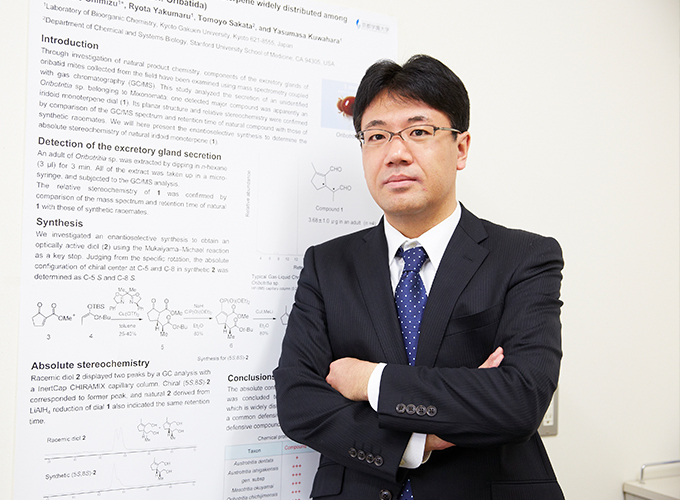Nobuhiro Shimizu
Professor, Ph.D. in Agriculture
- shimizu.nobuhiro

- Areas of Research
- Natural Products Chemistry, Chemical Ecology, Organic Chemistry
- Profile
- Research
-
Dr. Nobuhiro Shimizu received his Ph.D. in Agriculture from the Department of Applied Life Sciences of the Graduate School of Agriculture at Kyoto University in 2003. The theme of his doctoral thesis was the search for pheromones and their biological activities in astigmatid mites. In addition to identifying several aggregation and alarm pheromones, he also identified several new compounds.
After obtaining his doctoral degree, he spent two years as a postdoctoral researcher at the Graduate School of Pharmaceutical Sciences at Osaka University, where he researched anti-HIV and anti-malaria drug development. Following this, he spent one year as a postdoctoral researcher at the Faculty of Physiology at the University of Wisconsin, where he was involved in the synthesis of neural probes.
Upon his return to Japan in 2006, he took up a position at the newly established Faculty of Bioenvironmental Sciences at Kyoto Gakuen University (now Kyoto University of Advanced Science). His main subjects of instruction consist of specialized courses such as Organic Chemistry, Instrumental Analysis, Organic Reaction Mechanism, and Bioorganic Chemistry, as well as laboratory courses such as Chemistry Experiment and Organic Chemistry Experiment. -
It is well known that insects communicate with each other by emitting odors called pheromones. So how are the odors produced in the insects’ bodies? Determining that is one of the research themes of the Bioorganic Chemistry Laboratory. Mites are the main research subject. While many mites are harmless, some of them develop on flour and other powders, stick to the roots of crops, and can cause allergic dermatitis. Their very small size makes them difficult to control, but if it is possible to determine how pheromones are produced, it may lead to being able to control their development. Pheromones are organic compounds synthesized in the body. In insects, organic molecules are gradually changed by the action of proteins, and finally, the finished organic compounds are released as odors. If the details of this biosynthetic pathway are understood, it can pave the way to revolutionary pest control.
Pheromones are not the only odors that insects emit from the body. When they are about to be attacked, they can emit a “defense substance” that may drive their predator away. The Bioorganic Chemistry Laboratory is also working on the possibility of using this odor to make pesticides and repellents. This research originally began with a consultation from a manufacturer of horticultural products who wanted to make pesticides and repellents using natural ingredients. Dr. Shimizu’s team was able to find a fairly promising substance, but unfortunately, it has not been commercialized due to cost-related issues. They are searching for a new substance that is inexpensive, easy to obtain, and highly safe. So far, no insecticide that uses the smell of insects is available as a commercial product. If students entering the lab can discover a useful substance, there is a good chance it will lead to the development of a breakthrough product.
Kyoto Kameoka Campus is a place rich in nature, and the insects that inhabit it are often used as research materials. In the past, some students studied a type of springtail that is found in rotting trees. As its name suggests, most springtails escape from predators such as ants by leaping using the furcula in their rear end, but some species can’t. How can they survive despite being unable to hop? Dr. Shimizu’s team started by looking at their life histories to find out, and eventually, it was discovered that they emit odors that are repellent to ants. The ability to chemically examine the ecology of insects is what makes bioorganic chemistry interesting. Why not gain a better understanding of living things through your chemistry knowledge and unravel the mysteries of ecology?
In addition to these studies, the Bioorganic Chemistry Laboratory focuses on the exploration and research of antimicrobial substances. Antibiotics have always targeted microbes such as actinomycetes on land, as well as secondary metabolites produced by plants, but the discovery of innovative antibiotics is less common than in the past. The recent focus on marine microbes has led to a search for antibiotics, but no remarkable discoveries have been made quite yet. With this as the background to their research, Dr. Shimizu’s laboratory has been searching for new antimicrobial substances, including those produced by the arthropods themselves, as well as those produced by the microbes that live on or in the body of the arthropods. They are developing entirely new research that focuses on organisms that have not received attention and the microbes that live with them. They strive to achieve a healthy and comfortable life for people by using these natural materials and applying them to medicine and agriculture.